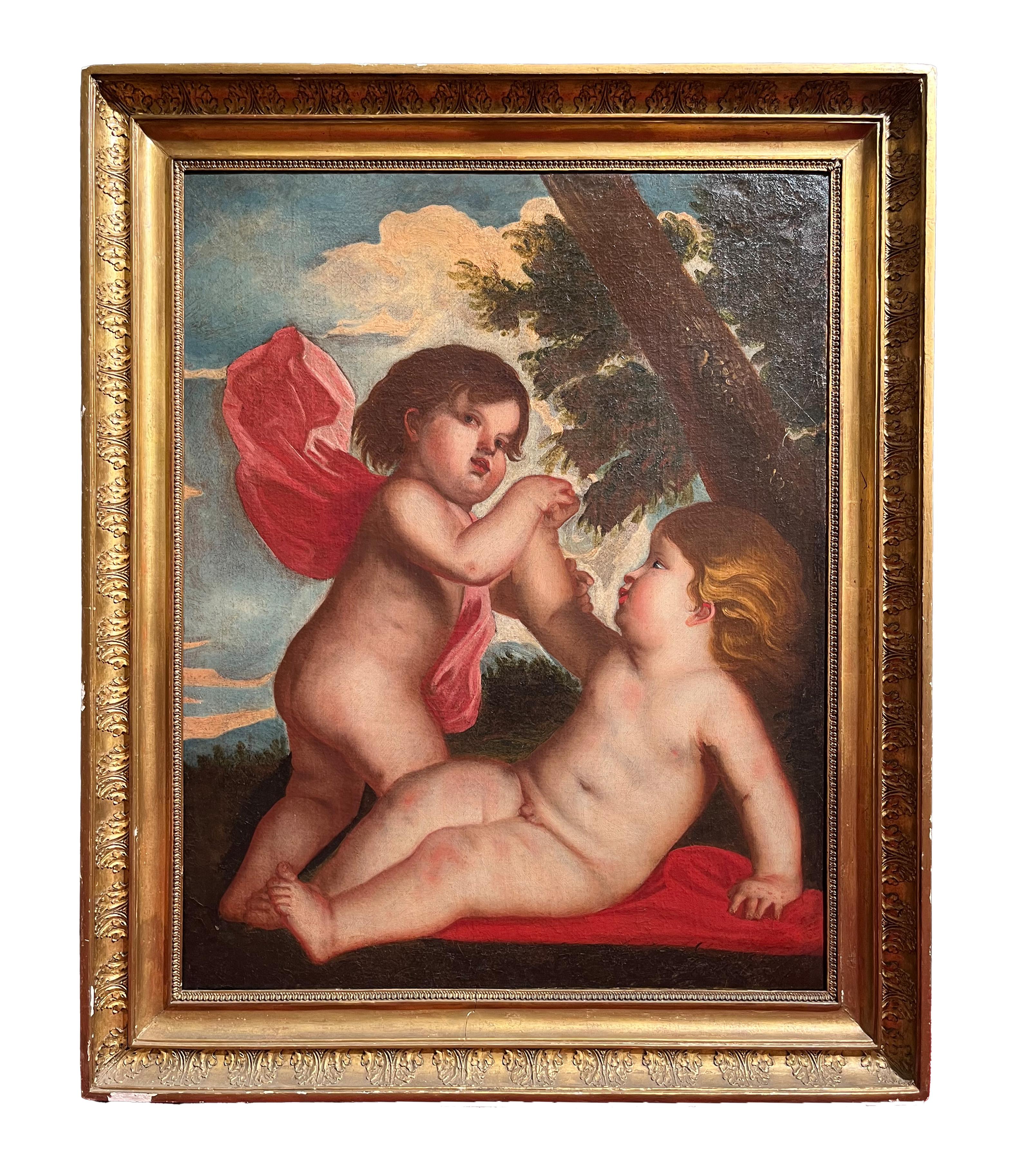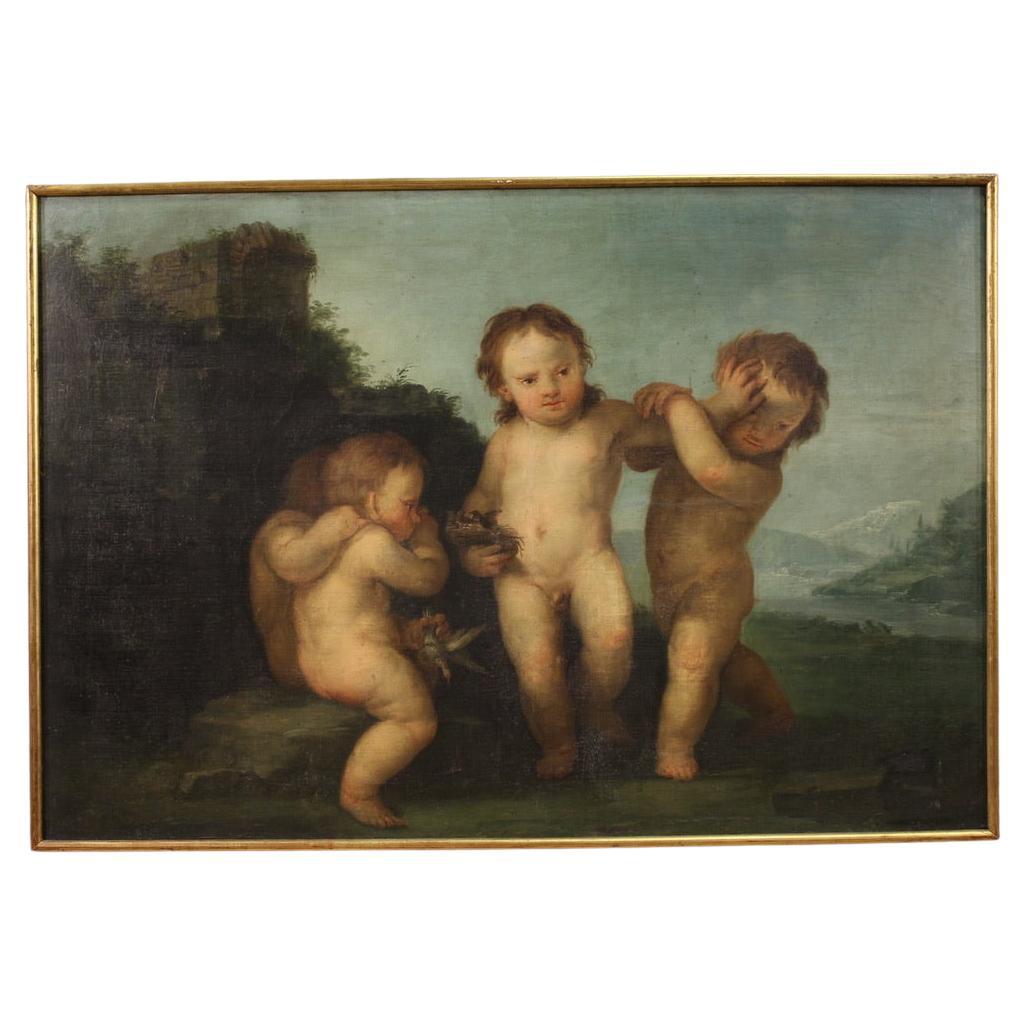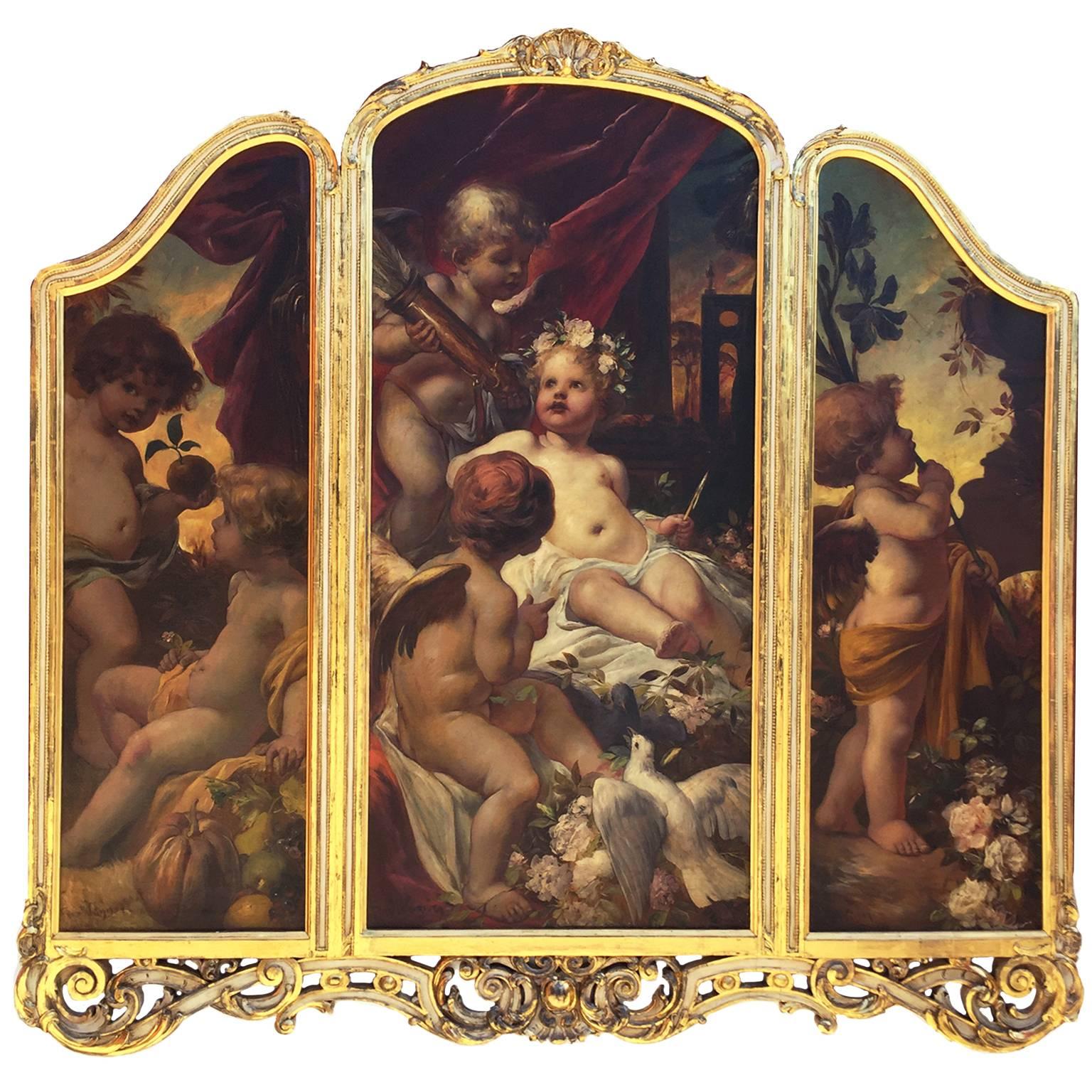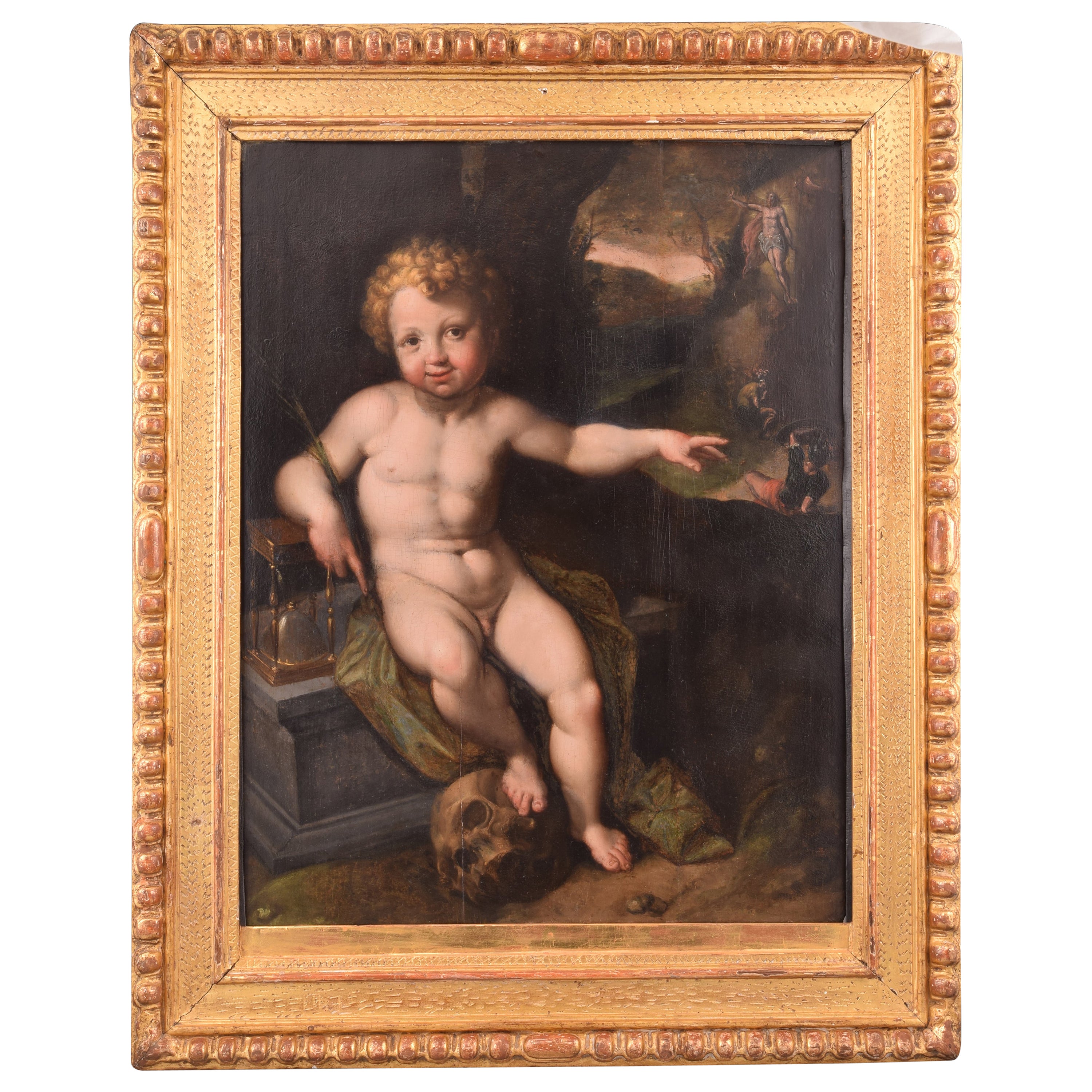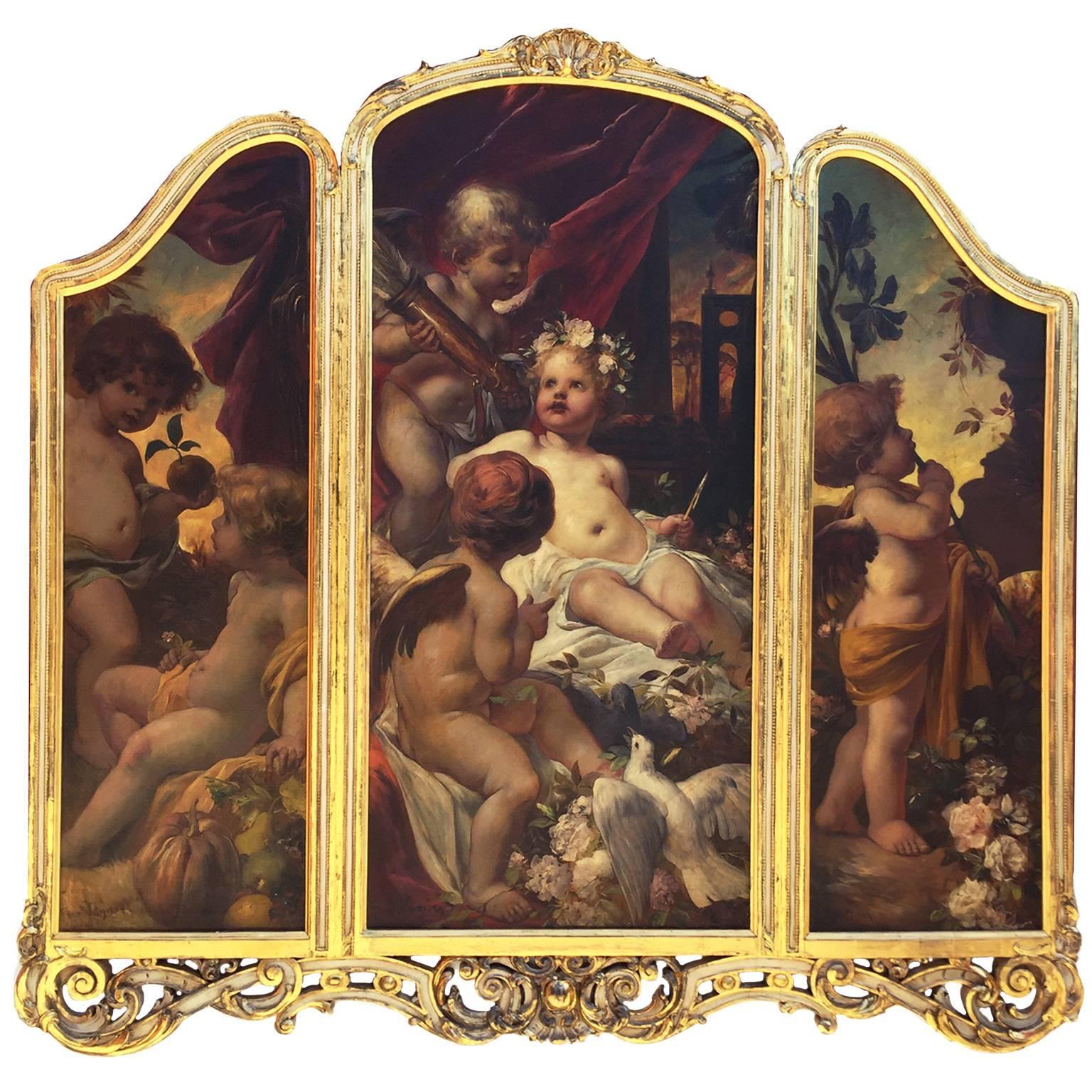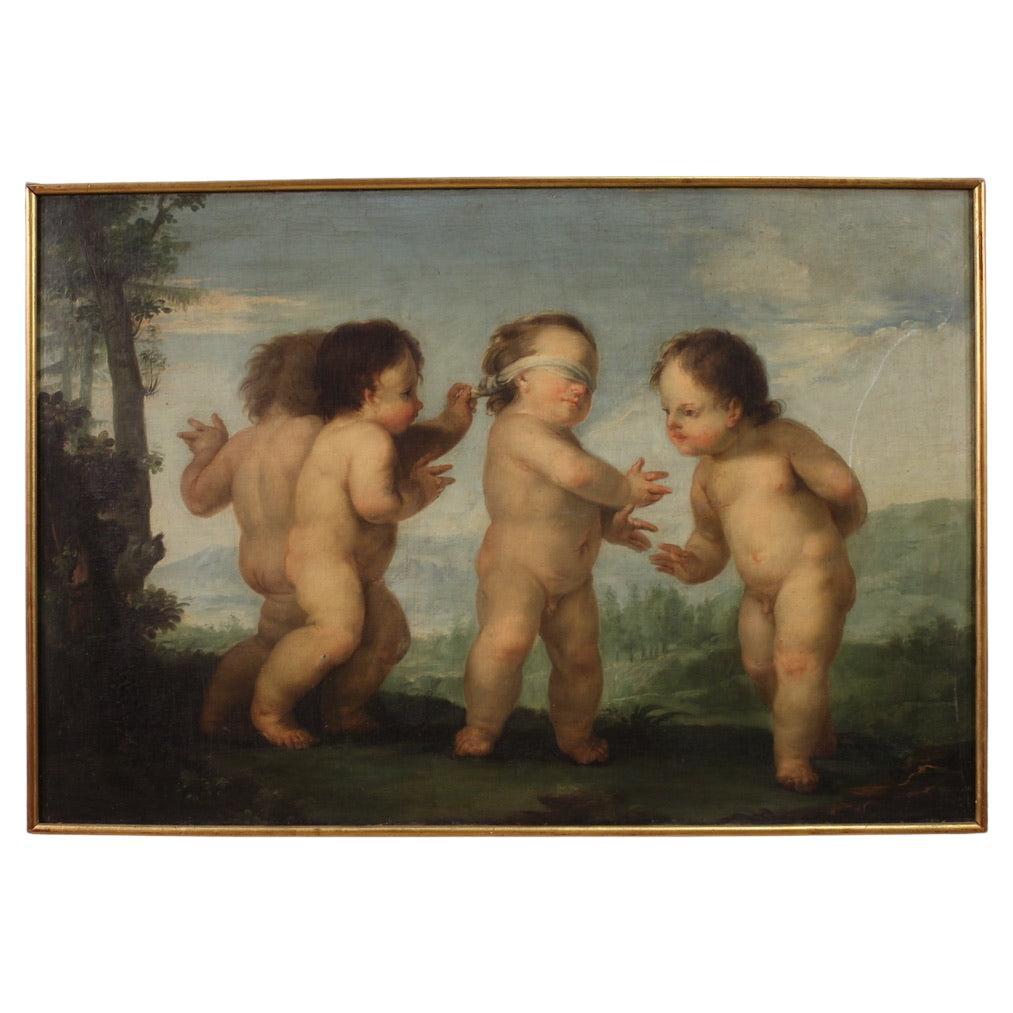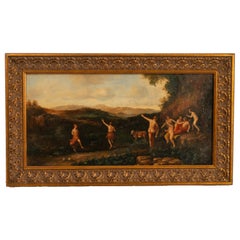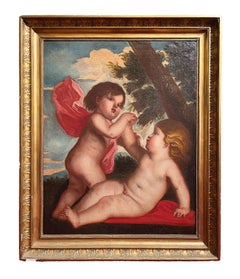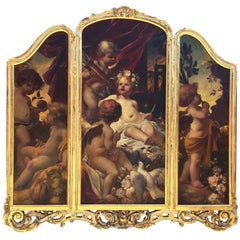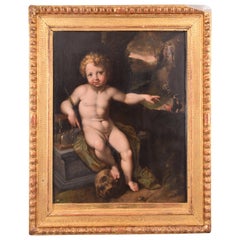Items Similar to Austrian Old Master Baroque Oil Canvas Painting Architecture Allegory Cherubs
Want more images or videos?
Request additional images or videos from the seller
1 of 16
Franz Xaver Karl PalkoAustrian Old Master Baroque Oil Canvas Painting Architecture Allegory CherubsCirca 1750
Circa 1750
$6,995
£5,278.93
€6,043.58
CA$9,865.27
A$10,830.84
CHF 5,650.47
MX$131,068.18
NOK 70,819.87
SEK 66,730.94
DKK 45,113.72
About the Item
An important & large oil on canvas Baroque painting by the Bohemian Old Master artist, Franz Xaver Karl Palko (1724-1767), an allegory of architecture, circa 1750.
The painting depicts a heavenly scene with a host of cherbs, some hold floral arrangements, the cherbs with their modesty covered with sheets of silk. To the lower part of the painting there are two cherubs, one cherub with a square & compass and a sketch of a timbered house.
The painting is housed in a chip-carved gilded wooden frame, the painting is in very good condition and is ready to grace your wall.
Provenance; From an important private collection, Italy.
Palko's training took place in the family workshop, and at the Academy of Fine Arts in Vienna, but it was his stay in Venice that defined his style and passion for theatrical scenography. In 1754 he created the decoration, unfortunately destroyed, of the Chapel of St. John of Nepomuk in the Court Church of Dresden and then settled in Prague, where he painted the vault with the legend of the saint and an altarpiece in St. John of Nepomuk, and then moved to Zbraslav in Cistercian abbey to work on the summer refectory with the 'Multiplication of the Loaves'. Palko is considered as the most important artist active in Bohemia in the middle of the 1700s.
Franz Xaver Karl Palko (3 March 1724, Breslau - c. 1767, Prague) was a Silesian painter; known primarily for religious scenes, although he also did portraits and engravings.
He was the son of a painter named Anton Palko (died 1754), about whom little is known. he began his studies at home, then went to Vienna, where he studied at the Academy of Fine Arts. In the 1740s, he was enrolled at the Accademia di Belle Arti di Venezia and came under the influence of Giuseppe Crespi. After returning, he worked in Bratislava, Kroměříž and Brno; finally settling in Dresden, where he painted frescoes depicting the life of Saint John of Nepomuk.
In 1752, he was appointed a court painter for the Electorate of Saxony, but moved on to Prague before a year was over, having received a commission from the Society of Jesus to paint frescoes at St. Nicholas Church. However, the Painter's Guild protested, noting that he was neither a guild member nor a citizen of Prague and was therefore undesirable. The following year, a Magistrate ruled that he could finish his work, on the grounds that being a court painter was equivalent to guild membership.
He never became a citizen of Prague, but stayed there for many years. Most of his works appear to have been frescoes or altarpieces. At some point, he was married, as there are baptismal records for a son, Jan Xaver, dating from 1756. The mother's name is given as Marie Anna Bursch, from Saxony.
Exact information regarding his death is not available. He apparently died in Prague in 1767, although other sources indicate that he moved to Munich in hopes of becoming a court painter for the Electorate of Bavaria, but was unsuccessful and died there, in poverty, in 1770.
His brother, Franz Anton Palko was also a well-known painter.
Framed: 44.25" tall x 32.75" wide x 1.5" deep
At sight: 33.75" tall x 25.25" wide
- Creator:Franz Xaver Karl Palko (1724 - 1767, German)
- Creation Year:Circa 1750
- Dimensions:Height: 44.25 in (112.4 cm)Width: 32.75 in (83.19 cm)Depth: 1.5 in (3.81 cm)
- Medium:
- Movement & Style:
- Period:1750-1759
- Condition:Very good condition.
- Gallery Location:Portland, OR
- Reference Number:Seller: BB-93261stDibs: LU1366211664712
About the Seller
5.0
Gold Seller
Premium sellers maintaining a 4.3+ rating and 24-hour response times
Established in 1990
1stDibs seller since 2020
61 sales on 1stDibs
Typical response time: 1 hour
- ShippingRetrieving quote...Shipping from: Portland, OR
- Return Policy
Authenticity Guarantee
In the unlikely event there’s an issue with an item’s authenticity, contact us within 1 year for a full refund. DetailsMoney-Back Guarantee
If your item is not as described, is damaged in transit, or does not arrive, contact us within 7 days for a full refund. Details24-Hour Cancellation
You have a 24-hour grace period in which to reconsider your purchase, with no questions asked.Vetted Professional Sellers
Our world-class sellers must adhere to strict standards for service and quality, maintaining the integrity of our listings.Price-Match Guarantee
If you find that a seller listed the same item for a lower price elsewhere, we’ll match it.Trusted Global Delivery
Our best-in-class carrier network provides specialized shipping options worldwide, including custom delivery.More From This Seller
View AllAntique 19th Century Neoclassical Bacchanal Painting Dancing of the Nymphs 1850
By Cornelius van Poelenburgh
Located in Portland, OR
A good antique Dutch/Flemish oil on panel painting, after Cornelis van Poelenburgh, circa 1850.
The painting portrays a number of nude and par...
Category
Mid-19th Century Old Masters Figurative Paintings
Materials
Oil, Panel
Italian Renaissance Tempera on Parchment Painting Holy Family by Giuseppe Cesari
Located in Portland, OR
A rare & important Italian Renaissance tempera on parchment painting, Giuseppe Cesari Il Cavalier d'Arpino (Giuseppe Cesari, 1568-1640), the painting c...
Category
16th Century Renaissance Figurative Paintings
Materials
Parchment Paper, Egg Tempera
Italian Early 17th Century Renaissance Baroque Oil Painting Entombment of Christ
Located in Portland, OR
An important & large Italian Baroque period oil painting on panel attributed to Daniele Crespi (1598-1630), "The Entombment of Christ", Milan circa 1620. See artist biography below.
...
Category
1620s Baroque Paintings
Materials
Oil, Panel
Flemish Early 17th Century Old Master Oil on Panel Painting Hunting Scene 1620
Located in Portland, OR
A highly important Flemish Old Master oil painting by Peter Van Lint (1609-1690), titled "Preparing for the Hunt", the painting is dated & signed by the artist, 1620. The painting wa...
Category
1620s Old Masters Landscape Paintings
Materials
Oil, Panel
Antique Swedish Oil Canvas Painting Romantic Interior Family Scene Monkey 1883
Located in Portland, OR
A fine & large antique oil on canvas painting by Bengt Nordenberg (1822-1902), Sweden, dated 1883.
Nordenberg is recognized as one of Sweden's most celebrated 19th century artists, his work epitomizes Swedish Romanticism and this painting is a wonderful representation of that style. The painting depicts an interior scene of a mother holding an infant in front of an open heath, with a fire burning in the grate, above the fire there are racks of meat hanging and above that are hams hanging. The infant has evidently just woken from a nap and his cradle sits next to his mother's chair, his brother sitting on the floor with his monkey & the carrying case he transports the animal to beg for money, the monkey humorously sits with his begging plate outstretched to the boy's mother, much to her consternation!
The painting is signed and dated lower left, it is in very good condition and is housed in the original gilded composition and limewood frame, Nordenberg's record for a painting at auction is over $91,500, this is a fine example of the artist's work and is ready to hang on your wall. Bloomsbury Fine Art & Antiques ship globally, very well packed & insured to ensure safe delivery.
Bengt Nordenberg (1822-1902) was a master of Swedish Romanticism. He belonged to the Düsseldorf school of painting & is best known for his genre paintings with everyday life scenes from the Dalarna, Skåne and Blekinge areas of Sweden. He moved to Düsseldorf in the 1850s. Nordenberg was born at Jämshög in Blekinge County, Sweden, he was one of nine siblings born to Per Jönsson Nord (1785-1854) and his wife Sissa Bengtsdotter (b. 1792). He grew up in poverty and became an apprentice to a painter in Sölvesborg.
In 1843 he studied at the Royal Swedish Academy of Arts in Stockholm, In the autumn of 1851 he went to the Düsseldorf Academy, where first Theodor Hildebrandt and then later, Adolph Tidemand...
Category
1880s Romantic Figurative Paintings
Materials
Canvas, Oil
Large Antique German Oil Canvas Hermann Frobenius Pre-Raphaelite Painting 1900
Located in Portland, OR
A Large and impressive antique oil on canvas Pre-Raphaelite painting by the German artist, Hermann Frobenius (1871-1954), signed and dated 1900.
Frobenius had classical training and studied both in Rome and Florence, he later was in the circle of Arnold Bocklin and Hans von Marees, he settle in Munich but also in Dresden briefly and latterly in Berlin. He, like many other European painters was fascinated with North Africa and painted many oriental scenes of Algiers, Tunis and Cairo, he was represented at many exhibitions, including the "Great German Art Exhibition" in Munich 1941.
This painting (an early example of the artist's work) is very finely painted in the Pre Raphaelite style, depicting a medieval costumed...
Category
Early 1900s Pre-Raphaelite Figurative Paintings
Materials
Canvas, Oil
You May Also Like
17th Century by Il Padovanino Pair of putti Oil on canvas
By Il Padovanino
Located in Milano, Lombardia
Alessandro Leone Varotari, detto il Padovanino (Padua, Italy, 1588 - Venice, Italy, 1649)
Title: Pair of putti
Medium: Oil on canvas
Dimensions: without frame 83 × 66 cm – with frame...
Category
17th Century Old Masters Figurative Paintings
Materials
Canvas, Oil
18th Century Oil on Canvas Italian Cherubs Game Antique Painting, 1760s
Located in Vicoforte, Piedmont
A magnificent 18th-century Italian painting. This oil on canvas painting depicts a splendid idyllic landscape with nude cherubs at play. One of them proudly displays a nest full of b...
Category
Antique 1760s Italian Paintings
Materials
Canvas
German 19th Century Oil on Canvas Triptych of Cherubs by Ferdinand Wagner II
By Ferdinand Wagner II 1
Located in Los Angeles, CA
Ferdinand Wagner II (German, 1847-1927) A very fine and charming triptych group of three oil on canvas laid on board titled "An Allegory to Spring" each panel depicting different playful and joyous scenes of putti and a cherubs reminiscent of spring, love and peace. The center panel depicting a seated putto, crowned with flowers, a standing putto behind him holding a sack of arrows and a seated cherub facing him next to a watchful peace dove on top resting of a flower bouquet. The left panel depicting a seated putto next to a standing putto with a freshly harvested apple. The right side panel depicting a standing cherub holding a fig branches with leaves. All three-in-one panels within individually carved giltwood frames. All panels signed at the lower left: Ferd. Wagner, circa 1890.
Ferdinand Wagner II (German, 1847-1927) was the son of Passau Ferdinand Wagner Senior, a teacher at a vocational art school who began training him professionally at a young age. After traveling to Italy in 1867-1868, he continued with his art studies at The Munich Academy of Arts led by Peter Von Cornelius and Julius Schnorr...
Category
Antique Late 19th Century German Rococo Revival Paintings
Materials
Canvas, Wood
Allegory of Time. Oil on panel. Circle of Jacob de Backer (act. 1571-1585).
Located in Madrid, ES
Allegory of Time. Oil on panel. Circle of Jacob de Backer (act. Antwerp, 1571-1585).
Exhibition: “Reality, time and artifice. Still life and vanitas in baro...
Category
Antique 16th Century Belgian Renaissance Paintings
Materials
Other
Charming 19th Century Oil on Canvas Triptych of Cherubs 'An Allegory to Spring'
Located in LA, CA
Ferdinand Wagner II (German, 1847-1927) A very fine and charming triptych group of three oil on canvas laid on board titled "An Allegory to Spring" each panel depicting different pla...
Category
Late 19th Century Academic Figurative Paintings
Materials
Oil
18th Century Oil on Canvas Italian Painting Game of Cherubs, 1760
Located in Vicoforte, Piedmont
A splendid 18th-century Italian painting. Oil on canvas artwork depicting a marvelous game of cherubs, of great pictorial quality. Immersed in an Arcadian landscape, four children ar...
Category
Antique 1760s Italian Paintings
Materials
Canvas
More Ways To Browse
Austria Painting
Two Cherubs
Baroque Architecture
Antique Vault
Austrian Oil Painting
Baroque Cherub
Cherub Frame
Antique Cherub Painting
Cherubs Oil Painting
Antique St Nicholas
Antique Battle Painting
Neapolitan Painting
Surreal Nudes
Abundance Painting
Contemporary Cowboy Art
Contemporary Painting Car
Naive French Folk Art Painting
African Faces
